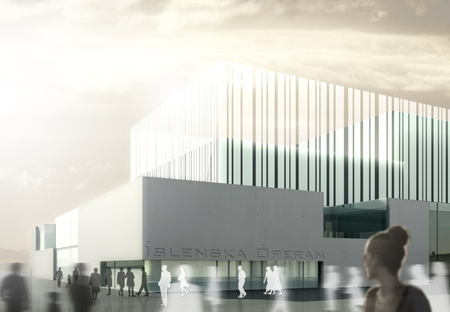
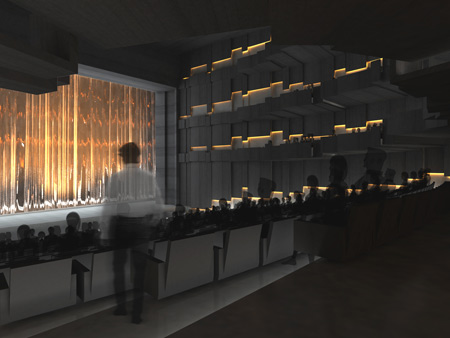
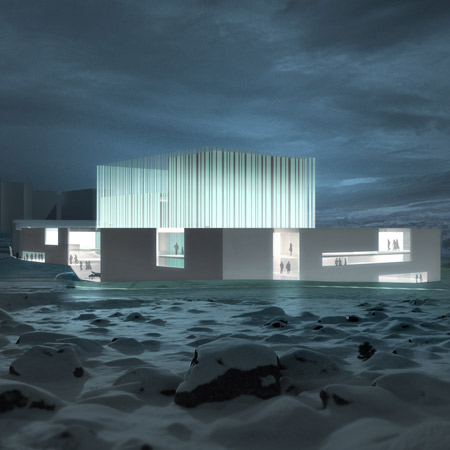
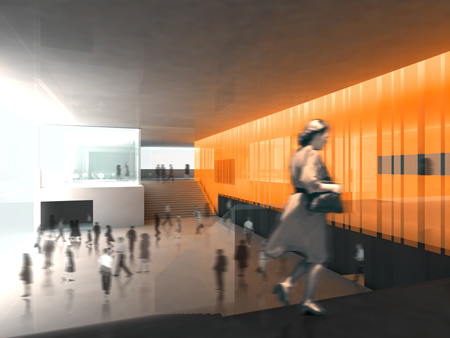
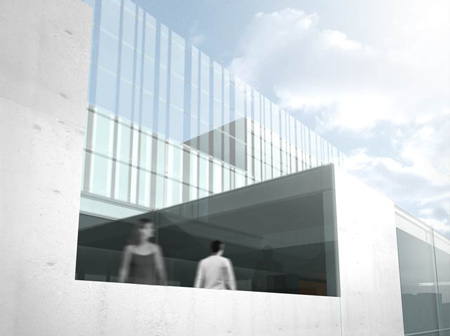
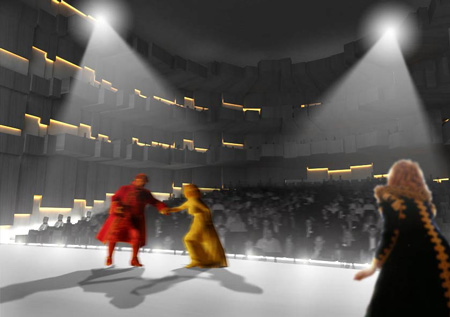
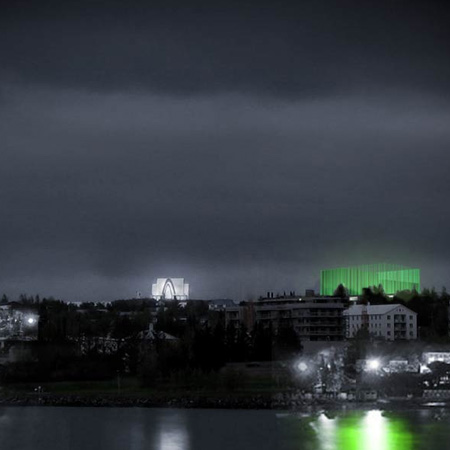
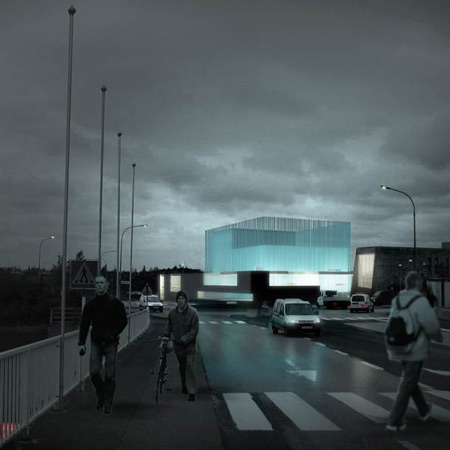
Icelandic
Opera House by Arkitema and Arkthing
Architects Arkitema of Denmark and Arkthing of Iceland have won a competition to design the Icelandic Opera House in Reykjavik.
The 820 seat concert hall will be situated on Borgaholt hill, near the city’s landmark the church of Kópavogs, in an area supposedly inhabited by elves.
The competition involved three teams of international architects presenting designs in collaboration with local Icelandic firms.
The national opera in Iceland aquires a new shining opera house with views to elf hill and the surrounding town.
When building in Iceland up to the elf hill Borgarholt it demands a special in depth understanding of Iceland’s history. A completely new opera house for the Icelandic national opera deserves a building with presence and grace, a new cultural landmark for Reykjavik.
Arkitema and Arkthing’s winning proposal takes its concept based on these premises and has created a building both to the Opera, the elves, the capital’s residents and the town of Kopavogur in Reykjavik.
A new opera house that identifies itself to
the whole town
The Icelandic Opera is situated at a relatively high point in the town along the Borgaholt hill, where according to Icelandic folklore elves live. The hill is protected and at its centre lies one of the capital’s current landmarks, the church of Kópavogs, which can be seen from everywhere in Reykjavik.
With the inclusion of The Icelandic Opera,
the church now has a modern cultural counterpart that will also be lit up and
be a landmark in Reykjavik’s skyline. The opera respects this special location
by replicating the church’s rectangular form.
A building for the elves and other mythical
beings
Deep underground, in the highlands and
under the cliffs around Iceland live the elves. Their dens are not visible from
the outside, but it is believed that they live underground somewhere or other.
From the outside the elves’ homes are dark and enclosed, but from the inside a
radiant and crystalline space is revealed.
The Opera’s expressional form with its
heavy and massive lower floor level and its light and crystalline upper floor
level refers to the mythical home of the elves. The heavy expression of the
lower level is broken up with window openings that vary in size but which all
replicate the cubic form.
Over the base the transparent shining cubic
tower rises up, housing the main scene and the opera’s large concert hall which
can hold an audience of up to 820. The facade of the shining cube is a glass
screen with LED lights which give the facade an ever changing appearance, that
through the course of a day changes in colour and strength.
The characteristic cube is the Opera’s
landmark that will light up Reykjavik, and from the interior be the Opera’s
distinctive feature. The cube continues down through the building so that it is
visible from the interior, allowing the large foyer area to look directly into
the concert hall.
With the elf hill as their one neighbour
and the town as the other, the Opera is situated between history, tradition, a
modern urban district and a cultural landscape with a library, museum and
cultural centre.
Arkitemas presence in Iceland
Arkitema and the Icelandic architectural
practice Arkthing have a well established working partnership, where they have
worked together on many projects including the Cultural Building in Akureyri
which is at present under construction
For both practices the success has great
importance. At Arkitema, Hallgrimur Thor Sigurdsson, architect and creative
leader with the north Atlantic market as his focus area explains: “We are very
proud of winning the competition.
It is seldom that one gets the opportunity
to create such an exciting and prestigious project as an opera”. And continues,
“We at Arkitema, have worked for a long time in the Icelandic market. With this
competition in our practice, our presence there will be strengthened even more,
furthermore it is a cultural project which has a great sense of meaning not
only for the Opera, but for the town’s residents and provides Reykjavik with a
new shining landmark”.
The winning proposal was made public at a
press meeting in Reykjavik Friday 15th August at 14.00hrs local time. Three
teams were invited to the competition, with each team having a locally based
collaborator in their team. Out of the three teams, two teams progressed to the
second stage, that of Alark (IS) and David Crossfield Associates (NY) and
Arkitema (DK) and Arkthing (IS), who finally won the competition.
Project Description
The Icelandic Opera reflects its location
in its architectural expression. A location that is characterised by the
cultural urban landscape, the Borgarholt elf hill and the church as its
immediate neighbours. The initial concept for the Opera took its form from a
cubic geometry that is replicated throughout the whole building both on the
facade and the interior. The facade is characterised by the distinctive heavy
base, broken up by the large cubic window openings. Above, in sharp contrast to
the base, lies a shining and distinctive cube which continues through the
entire building.
The building is flexible and simply
constructed using the cubic form, which are also replicated in the concert
hall, where the walls and balconies are created from various cubic forms which
tie in with the building concept whilst providing acoustic regulation. The
Opera’s location next to the foot of Borgarholt hill provides a natural fall in
terrain which is incorporated within the building, the entrance lobby’s two
storeys rise up to the rest of the Opera building which is stretched over three
storeys.
One enters the Opera from a little square,
where three important cultural institutions are located. From the entrance one
can either continue to the foyer area or go directly to the concert hall and
restaurant. At the very top five roof gardens help to activate the building
from top to bottom and provide the guests with a view across Reykjavik.
Data
Address: Hamraborg, Kopavogur, Reykjavik,
Iceland
Size: 8.000 m² with an audience of 820
Client: Kopavogur Council
Architect: Arkitema and Arkthing
Landscape architect: Arkitema
Other consultants: Gade & Mortensen
Acoustic
Award: 1st Prize in invited international
architectural competition
Competition year: 2008
'REF. > Architecture' 카테고리의 다른 글
| [ Rogers Stirk Harbour + Partners ] Bodegas Protos winery (0) | 2008.08.31 |
|---|---|
| [ sereroArchiects ] NAM JUNE PAIK (0) | 2008.08.29 |
| [ Tezuka Architects ] Atelier in Ushimado (0) | 2008.08.28 |
| [ Jackson Clements Burrows ] Separation Creek House (0) | 2008.08.25 |
| [ sereroArchiects ] MEDIATHEQUE (0) | 2008.08.22 |